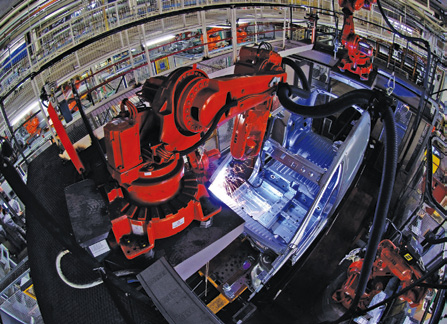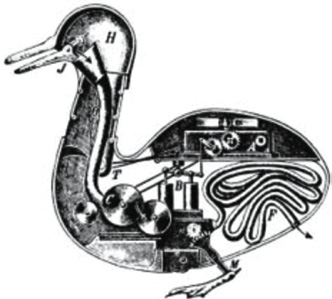
The word ‘robot’ originates from the Czech word for forced labour or serf. It was introduced by playwright Karel Capek, whose ficional robotic inventions were much like Dr Frankenstein’s monsters—creatures created by chemical and biological methods rather than mechanical. But the current mechanical robots of popular culture are not much different from these fictionalbiological creations.
The International Standards Organization (ISO) definesa robot as an automatically-controlled, re-programmable, multi-purpose and manipulative machine, with or without locomotion, for use in industrial automation applications.
Robotics is a fieldof multi-discipline engineering that deals with design, development and application of robots and the use of computer for their manipulation and processing.
Evolution of robotics
The history of robotics can be traced back to ancient Greece. According to Greek mythology, the Greek god of fire and forge—Hephaestus—was served by mechanical robots. Another historical record suggests an ancient Egypt origin for robotics, where priests used steam-activated mechanisms to open the doors of their temple.
Before the first electrician was born, the earliest reference to a robot was in ancient China, in the form of an organic robot given by an artificer called Yan Shi to King Mu of Zhou around 1000 BC. The robot was made of leather and glue with actual human organs, and it ceased functioning when the organs were removed.
It was around 350 BC when veteran Greek mathematician Archytas constructed a mechanical bird named ‘pigeon’—a robot powered by steam, which could fl. It was the firs recorded model airplane and a milestone in the history of robotics.
Between 1500 and 1800, odd mechanical marvels were springing up all over Europe. Leonardo Da Vinci was the next known robot designer after the ancient period. He invented a mechanical man in knight’s armour. John Dee of England invented a flying wooden beetle during the Elizabethan era. Another machine was Vaucanson’s ‘digesting duck’ in 1739, which was able to annoy real ducks, quack, eat grain and produce fake faeces. The duck was even referred to by Voltaire, albeit rather cryptically: “Without the duck of Vaucanson you have nothing to remind you of the glory of France.”
Isaac asimov’s laws of robotics
Law zero. A robot may not injure humanity or, through inaction, allow humanity to come to harm.
First law. A robot may not injure a human being or, through inaction, allow a human being to come to harm.
Second law. A robot must obey orders given by human beings, except where such orders would conflct with the first law.
Third law. A robot must protect its own existence as long as such protec-tion does not conflictwith the firstor second law.
Basic requirements of a robotic system
Some basic features of a robot include:
Mobility. It possesses some form of mobility.
Programmability. It implies computational or symbol-manipulative capabilities that a designer can combine as desired. So the robot is basically a computer, which can be programmed to accomplish a large variety of tasks. After being programmed, it operates automatically.
Sensors. Sensors sense the environment and give useful feedback to the device.
Mechanical capability. Robots act according to the environment rather than merely functioning as a data processing or computational device.
Flexibility. Robots operate with a range of programs and manipulate and transport materials in a variety of ways.
[stextbox id=”info” caption=”Robotics, then and now”]1801 A punch-card-controlled textile machine called Jacquard loom
1890 First autonomous vehicles (Tesla)
1922 First reference to ‘robot’ in Capek’s play Rossum’s Universal Robots
1938 Pollard and Roselund devised programmable paint sprayer
1946 DeVol—a general-purpose magnetic playback device for controlling machines
1946 Eckert & Mauchly devised ENIAC electronic computer
1948 MIT Prof. Wiener published Cybernetics
1952 First numerical control machine built at MIT
1954 Duvoll designed first programmable robot (Unimation—first robot company)
1959 Planet Corporation marketed the first commercially available robot
1962 GM installed first industrial robot on an assembly line
1964 Artificial Intelligence labs opened at MIT and SRI
1967 Mark II robot imported to Japan for paint spraying
1968 SRI built Shakey—first mobile robot operated using AI techniques
1970 First robot arm developed at Stanford
1973 T#—first minicomputer-controlled industrial robot (used extensively in the industry)
1976 Robot arms used on Viking 1 and 2 space probes
1977 ASEA (Europe) built first microcomputer-controlled robot
1980 s and on Rapid growth in the robot industry (Japan becomes the biggest player)
Source: http://www.cs.binghamton.edu[/stextbox]
Scope of robotics
Robotics requires the application of mechanical engineering, electrical/electronic engineering, computer-based integrated manufacturing, biological mechanics and software engineering.

A good depth in following major subjects is required to deal with robotics technology:
1. Artificial intelligenc
2. Engineering physics (mechanics)
3. Computer-aided design and computer-aided manufacturing
4. Computational geometry and simulation
5. Robot motion and path plan-ning/detection
6. Electronic control, communica-tion and navigation systems
7. Material science and technology
8. Optical engineering






